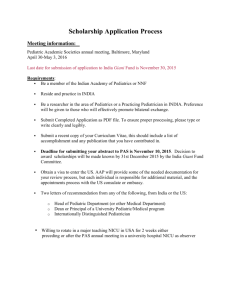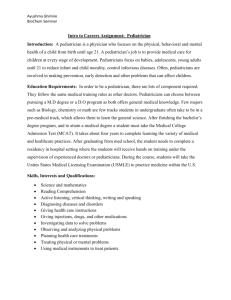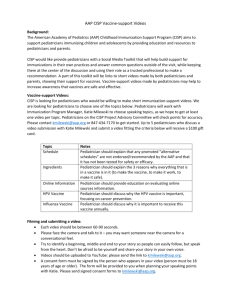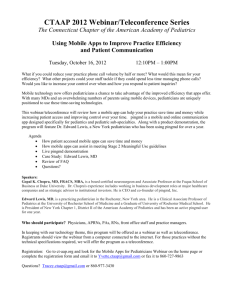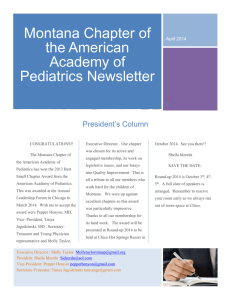Tania Pacheco Graduation Project
advertisement
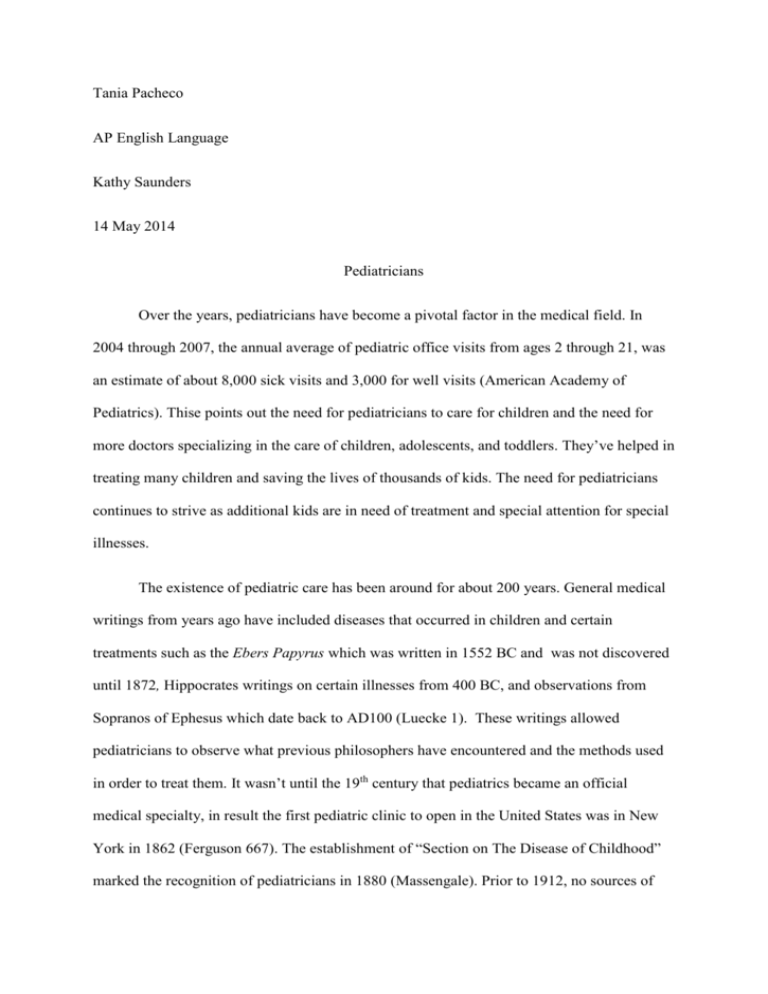
Tania Pacheco AP English Language Kathy Saunders 14 May 2014 Pediatricians Over the years, pediatricians have become a pivotal factor in the medical field. In 2004 through 2007, the annual average of pediatric office visits from ages 2 through 21, was an estimate of about 8,000 sick visits and 3,000 for well visits (American Academy of Pediatrics). Thise points out the need for pediatricians to care for children and the need for more doctors specializing in the care of children, adolescents, and toddlers. They’ve helped in treating many children and saving the lives of thousands of kids. The need for pediatricians continues to strive as additional kids are in need of treatment and special attention for special illnesses. The existence of pediatric care has been around for about 200 years. General medical writings from years ago have included diseases that occurred in children and certain treatments such as the Ebers Papyrus which was written in 1552 BC and was not discovered until 1872, Hippocrates writings on certain illnesses from 400 BC, and observations from Sopranos of Ephesus which date back to AD100 (Luecke 1). These writings allowed pediatricians to observe what previous philosophers have encountered and the methods used in order to treat them. It wasn’t until the 19th century that pediatrics became an official medical specialty, in result the first pediatric clinic to open in the United States was in New York in 1862 (Ferguson 667). The establishment of “Section on The Disease of Childhood” marked the recognition of pediatricians in 1880 (Massengale). Prior to 1912, no sources of Pacheco2 birth records or infant deaths were available, leading U.S. Congress to establish the Children’s Bureau; which made it mandatory for the parents of newborns to register the birth of their children to allow infant mortality to be recorded and known (Massengale). Although, many authors and famous philosophers have contributed into the pediatric field, only two authors have contributed to the workforce the most. Thomas Sydenham, whose known as the English Hippocrates, wrote on scarlet fever, small pox, rickets, and chorea also known as St. Vitus Dance. All of these diseases became the cause of many lives in previous generations, due to the uncertainty of how to treat them. Sydenham’s works helped allow modern pediatricians in acknowledging what went on throughout history. His stories allowed pediatricians and scientist to be able to find new medications and preventions for such illnesses. In addition, Edward Jenner of the late 18th century and early 19th century contributed to the prevention of diseases through immunizations, which he found out through using an 8-year old boy as his product and injecting the child with two types of diseases. Jenner inoculated the boy with cowpox matter into one arm and later inoculated smallpox matter into the other arm. The child did not contract small pox and the experience was effective in allowing the use of immunizations (Luecke 2). The care, development, and occurance of diseases became more popular in the late 1700’s and early 1800’s, specifically in Germany and in France. In 1883, in Germany, the first known organization in pediatric speciality was the Society for Infant Therapeutics. Which helped children in Europe getting medical attention when needed. A German pediatrician, who emigrated to New York in 1853, Dr. Abraham Jacobi was know as the “father of American pediatrics. Jacobi’s work was prominent due to his establishment of the pediatrics chair in 1861, organizations for pediatric societies, and development of children’s departments in New York hospitals (Luecke 3). Most children were attended by general practitioners for the first decades in the 1900’s until after World War I, when pediatricians Pacheco3 from various locations began arriving (Luecke 8). Over the years it’s been known that in 1991, there were an estimate of about 7,455 pediatric trainees on the road to becoming a pediatrician in difference to in 2007, when the number increase by three thousand up to 10,517 (Pletcher). When considering on whether or not to be a Pediatrician, one must think about whether or not they’re set up for the occupation. Skills in biology and chemistry are necessary to be good at. Another major factor when considering on becoming a pediatrician is being able to be around kids. Due to the hatred of doctor visits by younger children it become extremely difficult to be able to understand them and get to a conclusion on what may be going on with the patient. When treating children one must be able to effectively communicate with them in order to determine what’s wrong with the patient. Patience when trying to figure out the symptoms and emotions of a younger child is also important (Ferguson 664). Children’s fear to be anywhere near a doctor can be extremely high making it impossible for the child to communicate with the pediatric (Education Portal). For this reason, a pediatrician must be able to effectively speak as if the pediatrician was a child when communicating with the patient. A pediatrician must also be able to successfully use technology. New advances in the medical field is highly required and very common, along with reading literature and attending meetings in order to know advanced knowledge in the workforce (Ferguson 665). While in High School, some key classes to take into consideration are college prep classes especially those subjecting in math or science. Biology, chemistry, and any science related course and/or advanced math courses will come in handy throughout the pediatrics career. Pediatricians need to have knowledge of math skills when writing prescription to a patient, knowing exactly how much of a dosage is best is very important. Science skills allow a doctor to be able to analyze what the patient may be coming across. Having effective Pacheco4 communication skills is important, due to the requirement of the pediatrician to be capable of explaining treatment for illness; such as using sympathetic feelings when a patient is critically ill a pediatrician must be able to openly communicate with the parents (Education Portal). As well as being fluent in more than one language such as Spanish and English, or French and English is also a good quality of having. (Ferguson 665) Helping when patient’s parents need a translator and there’s not one around the facility will certainly come in handy when working as a pediatrician or any local hospital. (Ferguson 665). When considering a pediatrician career, volunteering at a local hospital may influence someone into whether or not that career is suitable for the person, by allowing them to experience what goes on in the ordinary life of a pediatricians work area (Ferguson 666). In previous generations, children were attended by local practitioners until after World War I, when pediatricians came into the medical field (Luecke 8). In modern times, pediatricians are the primary health care doctors who specialize in the health and care of new born infants, children and adolescents up to the age of 18, sometimes even up to 21 years old (Ferguson 662). Typically, pediatrics will see their patients every now and then, for yearly physicals, vaccinations, and illness preventions. Through observations when the patient gets a physical, the pediatrician will observe the skin texture, any unusual lumps on the child, and bruises and skin differentiation to determine whether or not the child may have any illnesses or diseases. In addition, through the examinations the pediatrician listens to the patient’s heart and lungs to note any abnormal beats or wheezing. Eyes and ears will be checked for any infections or illnesses, while height will be taken for growth development and weight is weighted for health observations such as those of obesity or underweight children (Ferguson 662). Immunizations are taken into place to prevent the child from contracting diseases such as HPV, polio, and small pox. (Ferguson 662) Pacheco5 Typically, pediatricians will treat common infectious diseases such as throat infections, seasonal influenzas, and respiratory diseases such as asthma and bronchitis, and continental abnormalities (Sacks). Pediatricians are also into the use of preventative care and recommend parents in doing many screenings to their children throughout the first 18 years. Before releasing a child from the hospital where birth was given, a pediatric recommends a congenital heart disease screen test to avoid future conflicts. Between the ages of 9 and 11, dyslipidemia screenings are recommended followed by a second screening between 18 and 21 years of age. Doctors will typically recommend but not pressure adolescents into being tested annually for depression during their young adolescent years of 11 through the age of 21 (American Academy of Pediatrics). Not only is the occupation of a pediatrician just to establish health conditions of a child and determine what will happen with the child in the future, but also to guide parents. The pediatrician will guide the parents of the individual, by teaching them the basics on nutrition. Such as how to properly proportionate food categories, without taken away the scrumptious meals a child may like. Parents are also guided into using effective safety precautions to avoid any harm to the child, along with how to maintain appropriate hygiene (Ferguson 662-663). When a child encounters a serious disease such as cancer, heart disease, or a serious case of asthma, pediatricians will arrange a referral to a specialist in the area that best treats and suits the disease (Ferguson 662). When finding out the period of further education needed, some may turn down the pediatrician career. After high school graduation, a future pediatrician will have to go through 4 years of undergrad course work, 4 years of medical school, and about 3 years of interns and residency. That’s a minimum of about 11 years of post-high school education (Shmoop). Following their bachelor’s degree, doctorate degree, and residency; pediatricians must legally obtain licensure every five years or as required by state. The licensure requires professionals Pacheco6 to pass a licensing exam and meeting educational requirements that will determine whether the pediatrician is still capable of working as a doctor or not (Education Portal). The procedure of becoming a pediatrician is quite similar to that of a doctor. Completion of a bachelor’s degree in any field of science is required. This could be a bachelor’s of science in chemistry, physics, and biology. Following the bachelor’s degree a pediatrician will be required to get their doctoral degree more commonly in Medicine but some may also be allowed to work with a doctor of Osteopathic Medicine Degree (Education Portal). The residency and internship that is mandatory following the completion of the degrees is typically a paid program that can add an additional years to your study, this is regularly done in a hospital setting or a university research hospital such as those of Duke, Johns Hopkins or St. Jude Children Hospital. Many pediatricians may wish to enter a specialty following their certificate in pediatric care. These specialties may include becoming a pediatric dentist, pediatric cardiologists, and a pediatric pulmonologists (Education Portal). In addition some expectations when entering the force are high knowledge of technological advances, how to use them and being a reliable source. Technology wise, many facilities have adapted to modern use of computers and other devices. In previous years, patients would be charged and ask to pay in cash, check or Blue Cross. This made it difficult for many families to be able to pay their dues or even visit a pediatrician. In difference to today’s society, insurance companies accept co-pay charges and have various types of coverage’s for families who are unable to fully pay coverage’s (Mourtos). Advances in technology and payment changes have made it easier for patients to be able to visit pediatricians and receive the adequate care even if their less fortunate in comparison to other families. From patients ranging in the ages of 0 through 21, 48.3% pay through their private insurance, 24.1% through Medicaid or SCHIP, 0.7% through Medicare, 19.9% through personal payments, and 7.0% through other methods (American Academy of Pediatrics). Pacheco7 Another major effect is the hardship many parents had to encounter due to the illegibility of them to be able to read the pediatricians handwriting. Now printed copies are used, records are kept electronically and a click away. This means that many pediatricians will be needed to be able to use laptops, tablets, and other computer related devices. Portals are open for patients to quickly and easily access their bills, renew prescriptions, and even request appointments, without having to give a call or travel to the office (Mourtos). The reliability of a doctor is always required. Due to the likeliness of a child or one of the patients becoming ill at any instant many pediatricians are on duty and call twenty four hours a day and seven days a week (Sacks 119). On average, a pediatrician will put in a total of about 47.5 hours a week, not including the emergency calls after work hours. During these hours, “65% will be devoted to office time, 19% doing hospital rounds, and 3% in a surgical room” (Sacks 119). Future pediatricians are ensured an average job outlook. Future pediatricians are ensured that the jobs outlook will increase about 24% in the years of 2010-2020 as confirmed by the U.S. Bureau of Labor Statistics (Education Portal). While many pediatricians are commonly self-employed due to their foundation of their own private practices, some pediatricians may even work at another pediatrician’s private facility. Pediatricians are also able to work with governmental organizations, such as your local health department. When working with a governmental organization a pediatrician will help determine epidemic issues affecting children around the world or even help countries where natural disasters have occurred. In addition, a percentage of pediatricians are typically employed in offices of hospitals or local practitioners (Education Portal). Pacheco8 In line for only working cognitive procedures in the diagnoses and treatments of certain illnesses, pediatricians are commonly seen to be in the lowest branch of salaries in comparison to the other medical field careers (Sacks 119). In comparison to other medical professions such as surgeons, special doctors and dentist, beginning pediatricians will earn about 100,000 a year. As the pediatrician moves up and is more experience they began earning anywhere from $140,000 to $160,000 (Shmoop). This is a cumulative average of about a minimum of $83,500 a year after taxes (Sacks 119). Although, the salary wage may seem slight in the medical field, job employment and location can boost a pediatrician’s salary earnings (Shmoop). In conclusion, the pediatrician workforce has played a contributing role in saving the lives of countless children and adolescents. These pediatricians are normally very busy and are always right around the corner when needed. They’re on call 24/7 and are reliable in helping a child. Through the advances of technology and payment types, pediatricians have been able to overcome the changes and continue striving for the goal to meet every child’s need and save lives. Pacheco9 Works Cited American Academy of Pediatrics. American Academy of Pediatrics. n.d. 17 May 2014 <http://www.aap.org/en-us/professional-resources/practicesupport/Pages/PeriodicitySchedule.aspx>. Web. "Profile of Pediatric Visits." American Academy of Pediatrics (2010): 1-16. Print. Education Portal. Education Portal. 2013-2014. 17 May 2014 <http://educationportal.com/articles/Pediatrician_Degrees_Program_Overviews.html>. Web. Pacheco10 Education Portal. 2014. 20 May 2014 <http://educationportal.com/related_pages/q_p/page/1/q_p/pediatrician_training.html>. Web. Ferguson. "Pediatricians." Exploring Health Care Careers. New York: Infobase Publising, 2006. 662-669. Print. Luecke, Percy E. "NCBI." The history of pediatrics at Baylor University Medical Center (2006): 1-9. Print. Massengale, Oliver. "NPPS: A Brief History of the Early Years." n.d. North Pacific Pediatric Society. 18 May 2014 <http://www.northpacificpediatricsociety.org/docs/history.pdf>. Print. Mourtos, Stacey. Metro Parent. July 2011. 18 May 2014 <http://www.metroparent.com/Metro-Parent/July-2011/Pediatrics-Then-and-Now/>. Web. Pletcher, Beth A. The Pediatric Workforce: What To Expect. n.d. 17 May 2014 <http://www.aap.org/en-us/professional-resources/Pediatrics-as-aProfession/Pages/Private/The-Pediatric-Workforce-What-to-Expect.aspx>. Web. Sacks, Teremce J. "Pediatrics." Careers in Medicine. Lincolnwood, Illinois: VGM Career Horizons, 1996. 118-119. Print. Shmoop. 2014. 17 May 2014 <http://www.shmoop.com/careers/pediatrician/>. Web. Pacheco11 Ferguson. (2006). Pediatricians. In Exploring Health Care Careers (pp. 662-669). New York: Infobase Publising. It wasn’t until the 19th century that pediatrics became an official medical specialty, in result the first pediatric clinic to open in the United States was in New York in 1862 (Ferguson 667). Pediatricians are one of the many doctors in the medical fields; they specialize in the health care of new born infants, children, and adolescents up to the age of 18 and sometimes even 21 (Ferguson 662). Typically, pediatricians will every now and then see their patient for yearly physicals. Throughout the checkups, a pediatrician will observe the child and vaccinate them to prevent future illnesses. During the examination a patient’s heart and lungs will be listened to for abnormal beats and wheezing or other triggers, eyes and ears will be checked for any infections in the ear or eye illnesses, height will be taken for growth development and weight will be weighed for health observations (Ferguson 662). Immunizations can be done during these routines in order to prevent children from contracting diseases such as rubella, polio, and small pox (Ferguson 662). Not only is the role of a pediatrician to take care of the patient in their care but also to guide parents on their child’s care and treatment, such as how to properly diet them, use effective safety precautions and use proper hygiene (Ferguson 662-663). When a child encounters a serious disease such as cancer, heart disease, or a serious case of asthma, pediatricians will arrange a referral to a specialist in the area that best treats and suits the disease (Ferguson 662). In order to become a Pediatrician, skills in biology and chemistry will be necessary. Another major factor when considering becoming a pediatrician is being able to be around kids. When treating adults one must be able to effectively communicate with them in order to determine what’s wrong with the patient. Patience when trying to figure out the symptoms and emotions of a younger child is also important (Ferguson 664). Being able to successfully use technology and new Pacheco12 advances in the medical field is highly required, along with reading literature and attending meeting in order to know advanced knowledge in the workforce (Ferguson 665) While in High School, some important classes to take are college prep classes especially those subjecting math and science. Biology, chemistry, any science related course and advanced math courses will come in handy throughout the pediatrics career. Having effective communication skills as well as being fluent in more than one language such as Spanish and English, or French and English will help when patient’s parents need a translator and there’s not one around the facility (Ferguson 665). When considering a pediatrician career, volunteering at a local hospital may influence someone into whether or not that career is suitable for them or not, by allowing them to experience what goes on in the ordinary life of a pediatricians work area. After High School, bachelor’s degree in premedical studies will be necessary followed by a M.D. degree, and a three year residency. (Ferguson 666) Sacks, Teremce J. "Pediatrics." Careers in Medicine. Lincolnwood, Illinois: VGM Career Horizons, 1996. 118-119. Typically, pediatricians will treat common infectious diseases such as throat infections, seasonal influenzas, and respiratory diseases such as asthma and bronchitis, and continental abnormalities. Pediatrician are typically on duty and call twenty four hours a day and seven days a week, due to the likeliness of a child getting sick at any instant. On average, a pediatricians weekly hours will consist of at least 47.5 hours a week. During these hours “65% will be devoted to office time, 19% doing hospital rounds, and 3% in a surgical room” (Sacks 119). In line for only working in cognitive procedures in the diagnoses and treatments of certain illnesses, pediatricians are commonly seen to be in the lowest branch of salaries earned in the medical field. Pediatricians average a minimum of $83, 500 a year after taxes, 33 percent of these pediatricians are women (Sacks 119). Pacheco13 Luecke, Percy E. "NCBI." The history of pediatrics at Baylor University Medical Center (2006): 1-9. The existence of pediatric care has been around for about 200 years. General medical writings from eras ago have included diseases that occurred in children and certain treatments such as the Ebers Papyrus which was written in 1552 BC was discovered in 1872, Hippocrates writings on certain illnesses from 400 BC, and observations from Sopranos of Ephesus which dates back to AD100 (Luecke 1). Although, many authors and famous philosophers have contributed into the pediatric field only two authors have contributed to the area the most. Thomas Sydenham whose known as the English Hippocrates, wrote on scarlet fever, small pox, rickets, and chorea also known as St. Vitus Dance; while Edward Jenner of the late 18th century and early 19th century contributed to the prevention of diseases through immunizations which he found out through using an 8-year old boy as his product (Luecke 2). The care, development, and occurance of disease became more popular in the late 1700’s and early 1800’s, specifically in Germany and in France. In 1883 in Germany, the first known organization in pediatric speciality was the Society for Infant Therapeutics. A German pediatrician, who emigrated to New York in 1853, Dr. Abraham Jacobi was know as the “father of American pediatrics. Jacobi’s work was prominent due to his establishment of the pediatrics chair in 1861, organizations for pediatric societies, and development of children’s departments in New York hospitals (Luecke 3). Most children were attended by general practitioners for the first decades in the 1900’s until after World War I, when pediatricians from various locations began arriving (Luecke 8). Shmoop. 2014. 17 May 2014 <http://www.shmoop.com/careers/pediatrician/>. To become a pediatrician, one must go through undergrad, medical schools, interns and residency, an overall total of about 11 years of school after high school graduation. A future pediatric must also pass the United States Medical Licensing Examination required by state Pacheco14 law. In comparison to other medical professions, becoming a pediatrician doesn’t win one the lottery but more frequently allows an individual to get enough to live an average life. Beginning pediatricians earn about $100,000 a year, and as a pediatrician moves their way up they start earning from $140,000 to $160,000. While this may be seem like a little in comaparison to other doctors, job employment can sometimes boost a pediatricians salary earnings (Shmoop). Adamson, Christopher. Education Portal. 2013-2014. 17 May 2014 <http://educationportal.com/articles/Pediatrician_Degrees_Program_Overviews.html>. A pediatrician must be able to effectively communicate with patients and parents, not to mention be able to communicate with younger children who are usually scared of medical facilities. Their required to explain treatment for illness, sympathetic feelings are also a great thing in a pediatrics personality. While many pediatricians are more commonly selfemployed due to their foundation of their own private practices, pediatricians are also able to work with a governmental organization to help determine epidemic issues affecting children around the world. In addition, a percentage of pediatricians are employed in offices of practitioners, and hospitals. Future pediatricians are ensured a 24% increase in job outlook from 2010-2020 as confirmed through the U.S. Bureau of Labor Statistics (Education Portal). Following their school work, doctors must legally obtain licensure every five years, requiring the professionals to pass a licensing exam and meeting educational requirements (Education Portal). The American Board of Medical Specialists directs general pediatricians to receive certification through the ABP short for the American Board of Pediatricians (Education Portal). American Academy of Pediatrics. American Academy of Pediatrics. n.d. 17 May 2014 <http://www.aap.org/en-us/professional-resources/practicesupport/Pages/PeriodicitySchedule.aspx>. Pacheco15 Major recommendations for preventive pediatric healthcare include testing newborns for critical congenital heart disease before being released from the hospital, screening children for dyslipidemia between 9 and 11 years, along with a second screening at 18 and 21 years of age. Adolescents are recommended to annually test for depression between 11 and 21 years of age, and for HIV between 16 and 18 years of age (American Academy of Pediatrics). Pletcher, Beth A. The Pediatric Workforce: What To Expect. n.d. 17 May 2014 <http://www.aap.org/en-us/professional-resources/Pediatrics-as-aProfession/Pages/Private/The-Pediatric-Workforce-What-to-Expect.aspx>. Over the past years it was stated that in 1991, there were 7,455 pediatric trainees on the road to becoming a pediatrician as to in 2007 the number increase by three thousand up to 10, 517. While two-thirds of the trainees in 2007 were females, an even greater percentage agreed on entering general practice (Pletcher). Massengale, Oliver. "NPPS: A Brief History of the Early Years." n.d. North Pacific Pediatric Society. 18 May 2014 <http://www.northpacificpediatricsociety.org/docs/history.pdf>. The establishment of a “Section on The Disease of Childhood” marked the recognition of pediatricians in 1880 (Massengale). Prior to 1912, no source of birth records or infant deaths were available, leading U.S. Congress to establish the Children’s Bureau; which made it mandatory for the parents of newborns to register the birth of their children to allow infant mortality to be recorded and known (Massengale). Mourtos, Stacey. Metro Parent. July 2011. 18 May 2014 <http://www.metroparent.com/Metro-Parent/July-2011/Pediatrics-Then-and-Now/>. Over the past 50 years, pediatricians health care has changed from health issues, technology to payments. Years ago, many facilities would charge patients and only accept cash, check or Blue Cross, now insurance companies will charge co-pays and have various types of coverages. Over the years, the hardship for parents to try to read their pediatricians Pacheco16 handwriting has changed for the better. In todays day, records are now kept electronically and a click away. Portals are now open for patients to easily access their bills, renew prescriptions, and even request appointments (Mourtos). "Profile of Pediatric Visits." American Academy of Pediatrics (2010): 1-16. From patients ranging in the ages of 0 through 21, 48.3% pay through private insurance, 24.1% through Medicaid/SCHIP, 0.7% through Medicare, 19.9% through personal payments, and 7.0% through other ways. In 2004 through 2007, the annual average of pediatric office visits from ages 2 through 21, was an estimate of about 8,000 sick visits and 3,000 for well visits (American Academy of Pediatrics).
